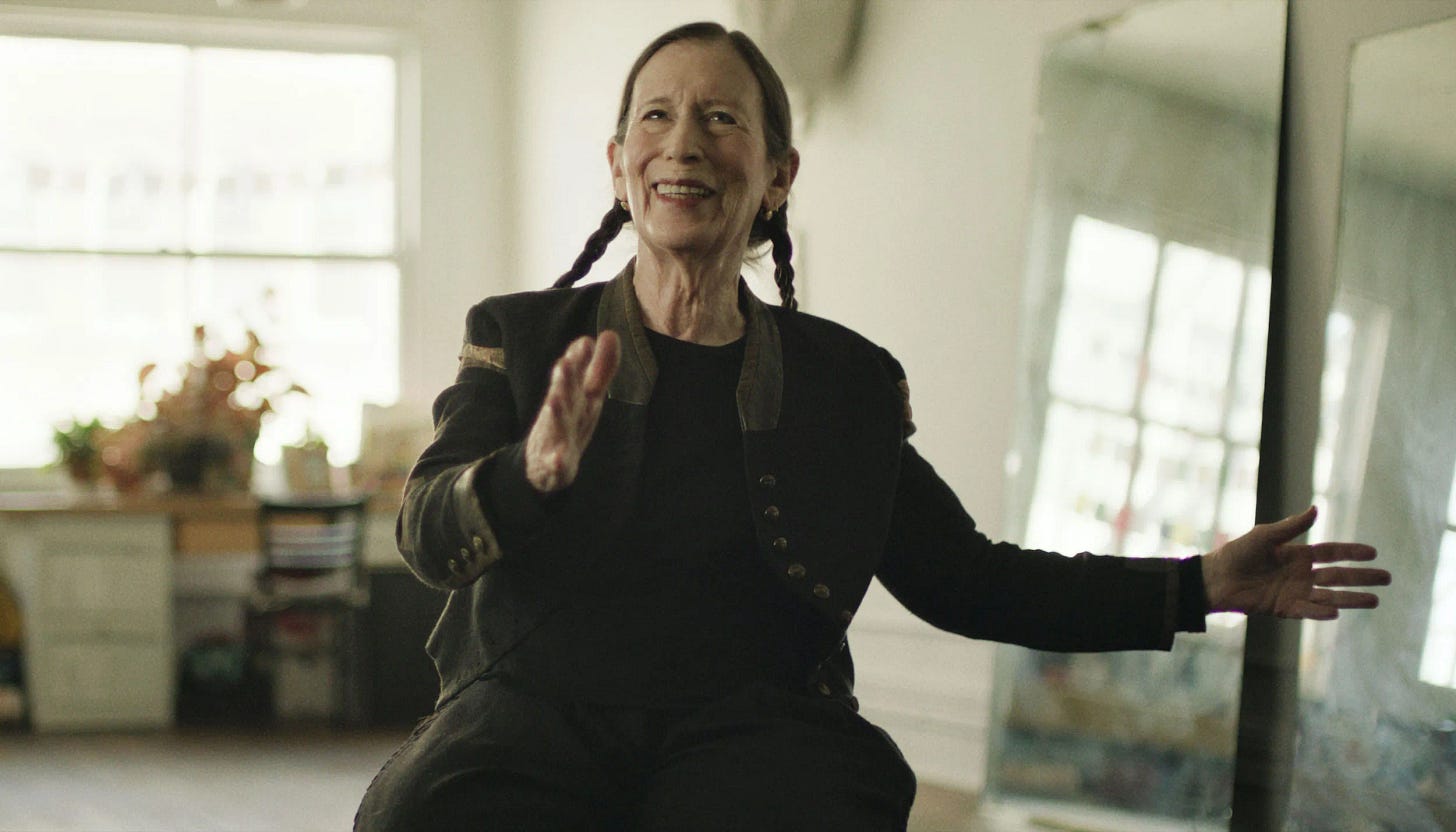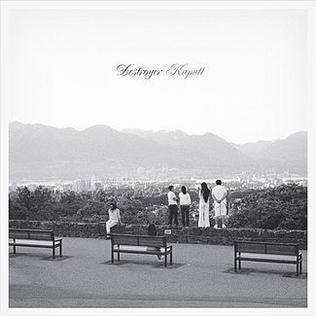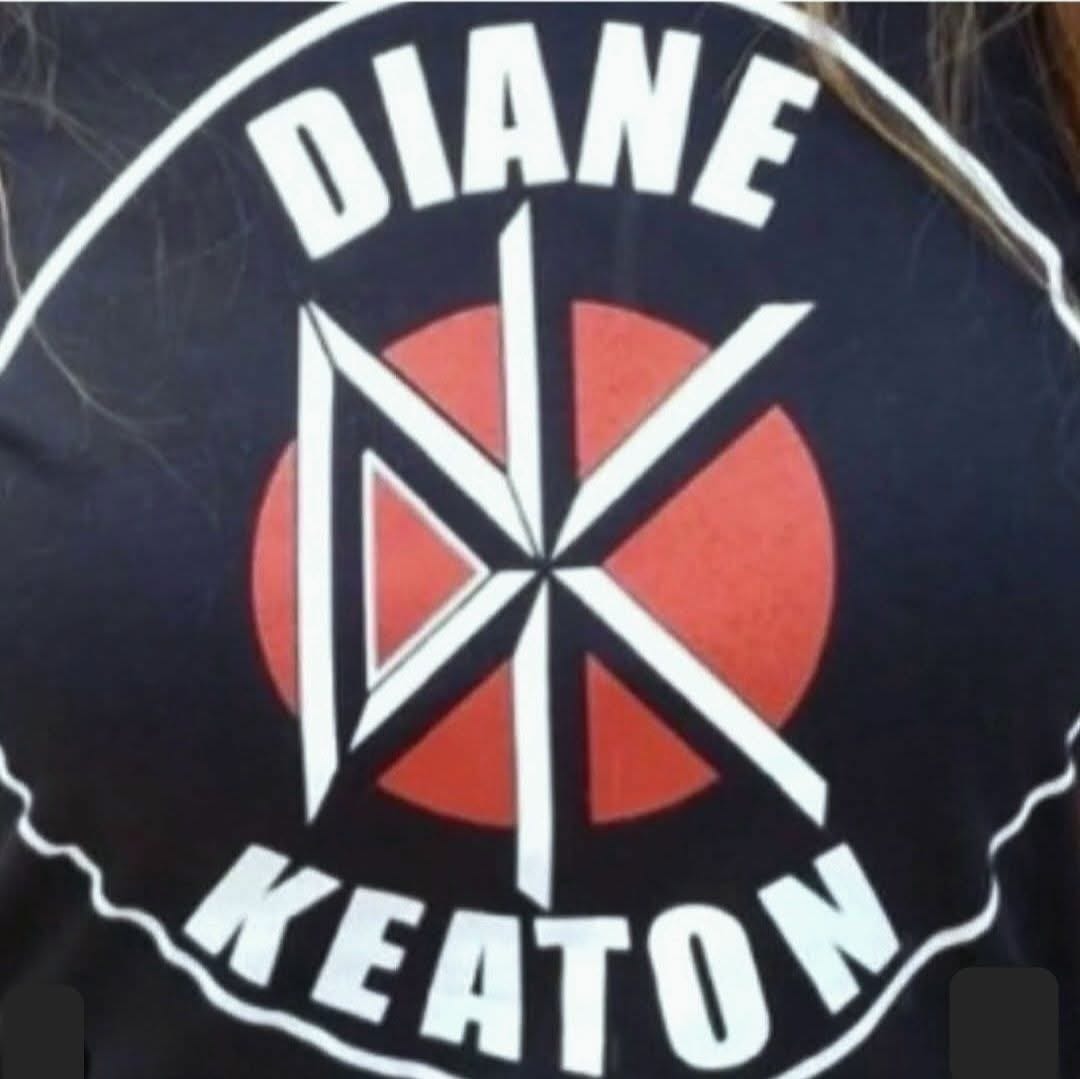Seems like old times
On the new Meredith Monk doc, D'Angelo, Spinal Tap, 'Kaputt-core' and Diane Keaton
In case you’re curious, yes, I wrote about the Taylor Swift album. Now, moving on.
Keele Life Top 5, 17.10.25 1
1. Monk in Pieces (Billy Shebar, 2025)

Last Saturday afternoon I was among fewer than a dozen people at one of only two showings of this new documentary about Meredith Monk at Hot Docs cinema in Toronto. I had Row F to myself. I know her name doesn’t come up that often, but in a city this size I assumed there’d be at least a couple of screenings’ worth of people who’d know.
People, that is, who’d know Monk as an NYC downtown fixture of similar stature to Laurie Anderson, David Byrne (who shows up here), or Philip Glass—who in the movie calls her “the uniquely gifted one” among their cohort. Monk came out of sixties Happenings and the performance loft scene to become, as Glass puts it, a “one-woman theatre company,” combining dance, drama, and especially music. Her unmistakable style of often wordless vocal composition melds minimalism with medieval polyphony, global folk musics, nature sounds, and wild childlike expression. It leaps registers both tonally and culturally.
As Byrne says in the film, Monk creates a sense of spontaneity that might be one reason she’s underestimated. Her works actually demand virtuoso precision. Here’s a performance of “Hocket” from 1992’s Facing North, a duet that thanks to Monk’s extended techniques sounds like a small ensemble. It’s a good example of how she evokes feelings “in between” the emotions we can normally name.
But she also staged and/or filmed epic pieces for large casts, such as Book of Days, the 1988 film on the theme of medieval plagues through which she grieved over the AIDS crisis.
In 1991, the Houston Opera commissioned her opus Atlas. The documentary has an amusing sequence of increasingly panicked letters from the opera admin over her offbeat rehearsal and casting demands, questioning whether the piece will ever open at all. (It did, on time.)
There’s a clue there to some of what’s interfered with Monk receiving full recognition (though Obama did award her the National Medal for the Arts). Her own physical presence is too implicated in the work for the comfort of most institutional new-music structures. A moving late section of the film deals with her confronting how the work can be performed after she dies, including not only notation but one-to-one training in her own oral tradition. But the music’s also too deeply abstract to translate to popular audiences as fluently as Anderson’s. And for years early on, her earthy physicality drew misogynist scorn in the press that the likes of Glass or La Monte Young never had to deal with.
The doc, directed by the husband of a long-time Monk ensemble member, conveys all these angles with a minimum of music-flick-talking-head monotony. It’s called Monk in Pieces because its mini-sections each hinge on a particular Monk piece tied to a broader biographical theme. This modularity is akin to the mobile structures of her music. With its archival footage and interviews with Monk, collaborators, and intimates across the decades to today, the film is a perfect introduction.
But for initiates (the right term for Monk fans), it also illuminates the links between, for instance, the eye-focus disorder she suffered from as a kid and the overlapping and separating layers of her music. As a preschooler her mother sent her to eurhythmic training to help the resulting coordination problems, which forever married Monk’s sense of music to movement. Oh and that mother? The daughter of Russian Jewish immigrant musicians herself, she was a New York swing singer (under the name Audrey Marsh) who made much of her living doing ad jingles for radio. But she ended up unemployed and depressed when no longer the hot young thing. So Monk swore off ever being tethered to the commercial music industry. At 82, she can call that a mission accomplished.
I can’t believe I never realized the link between Monk and Björk, who was introduced to Monk’s music by her first boyfriend in her early teens. It was “like a timeless door had opened… It affected my DNA. I knew every note.” In that light the influence seems blatant. On the night of Sept. 11, 2001, Björk performed Monk’s “Gotham Lullaby” at a concert in Stuttgart, dedicating it to the victims of the World Trade Center attack. (That footage is in the doc.)
There’s also a bit of real-estate voyeurism, as we revisit Monk in different periods in the same expansive (and no doubt then dirt-cheap) Tribeca loft-studio she’s lived in since 1972, often with the pet turtle who was her most constant companion for decades. Her speculations about the utter alienness of its consciousness inspired 1983’s Turtle Dreams.
If there’s a screening near you—as in Montreal this weekend, among others—please do vote with your butt in those seats. But if not, the film is available for streaming on Apple. Meanwhile, Monk’s latest album Cellular Songs was released this morning on the usual platforms. I’ve been listening as I write, and it’s as fine a place to start as any.
2. Goodnight, sweet D’Angelo (1974-2025)
Others have spoken and will speak much more eloquently and intimately to this wrenching turn, the final fall of this heir to the Prince. But I’m also feeling it. I was drawn to what Jamie Broadnax wrote on the Black Girl Nerds site about neo-soul (a term D’Angelo declined), that it was “never just about melody or groove, but it was about community, collaboration, and communion. These were artists who ... turned vulnerability into power ... intellectual and sensual, political and personal, sacred and messy all at once.” That gets at something I feel about Voodoo and Black Messiah.
I am ensorcelled by the creation myth of Voodoo, the idea of Questlove, D’Angelo, and their brilliant “Soulquarian” friends dropping in or hunkering down in the haze of Electric Ladyland studios to brainstorm, jam, and translate J Dilla’s digital production innovations to R&B instrumentation. Then later the way that power became vulnerability again. Including the plight of being sexually objectified to a degree few male stars have experienced, added to the kinds of objectification with which Black men were already way too familiar. D’Angelo’s subsequent crises of faith and confidence led to a chronic wayward dysfunction. Yet still he re-emerged in 2014 with another masterpiece.
That he ultimately put out so little music is a crying shame that never can be remedied now. But it’s a rare thing to leave behind such a near-perfect streak. Let’s hope we get to hear what he was working on in his last years, before long.
Meanwhile I can recommend the 2019 documentary Devil’s Pie, which catches all that history on the fly during the Black Messiah tour, without sensationalism, exploitation, or undue flattery. Questlove is there, articulating the thoughts he later elaborated in his Sly Stone documentary: That Black genius brings with it many burdens, always including survivor’s guilt. The sad “solution” to which is often not to survive, or barely. But the film also includes footage of that genius in action that will bring devotees and neophytes alike face to face with this loss.
Also: Pancreatic cancer is the worst. Fuck it to hell.
3. Spinal Tap II: The End Continues (2025)
I’m coming in late, but so did they. They waited too long and it seems the jokes got tired or at least the jokers did. It’s an utterly pleasant hang, and it was great they got a woman drummer (Valerie Franco), which kinda presaged what Rush is doing with Anika Nilles on their upcoming post-Neil Peart tour.
There aren’t a lot of lines I’ll be quoting. But Sir Elton does sound great singing “(Listen to the) Flower People” and “Stonehenge.” Like, fucking great. And here is one of the few lines I will repeat: Toward the end, Michael McKean’s David St. Hubbins says he’s working on a memoir: “I was inspired by Bruce’s book—I Am Springsteen Going on Spreventeen.”
Yep, that’s a pretty low bar. But I was tickled to hear the Bruce-biographical-industrial-complex taken down a gentle peg, especially this month. (Watch for my review of Deliver Me From Nowhere next week on Slate.)
4. ‘Kaputt-core’ cometh
Tickled also describes my reaction to stumbling across an article by New York writer Zach Schonfeld in Dirt magazine about the fraction of the Toronto music scene centered around ye olde Tranzac, and the way it’s been “making smooth jazz sound radical.” The piece uses Friend-of-“Crritic!” saxophonist Joseph Shabason as its focal point, linking the fact that he played on Destroyer’s then-definitely-radically-smooth Kaputt in 2011 to the current lite stylings of his posse like Dorothea Paas, Thom Gill, Masahiro Takahashi, Bernice (Robin Dann et al) and Fresh Pepper (Joseph and André Ethier). Hilariously calling the whole tendency “Kaputt-core,” Zach praises “the way it flirts with the cheesiest textures imaginable and dares you to flinch,” and its “recognition that cool and uncool are not meaningful signifiers when you’re middle-aged and making music that you believe in.”
I’ve written about this before, most notably in my essay here last winter centered around recent project CiCi Arthur (Chris Cummings, Shabason, and Gill), “Telling tender spots from funny bones.” I say there that at least via Cummings (as Mantler and then Marker Starling), we’ve had this in Toronto for 20 years. But I agree that Kaputt marked a wider shift. Today I would venture you can find this kind of loungey, New Agey thing all over, including in radical-minded U.S. and UK R&B and jazz like Sault, or the ones who played on Andre 3000’s flute platter, e.g.. But there is something distinctly Torontonian in the local version, in its split-perspective ironic sincerity/sincere irony, as well as arguably and less positively its noncommittal tendencies or even passive-aggression. That’s not to criticize any of the artists. Just to say that regional character is always a complex thing.
One reliable place to catch many of the Kaputt-core characters is at the monthly Holy Oak Family Singers themed-cover-songs event, the first Wednesday of every month at the Tranzac. Amusingly for Zach’s thesis, the Oct 1 edition’s theme was those old smoovies Steely Dan. (NB: In November it is the Spice Girls.) The versions were less re-envisioned than usual, as most of the players seemed to relish tackling the parts roughly as written. But there’s at least one unforgettable moment at most HOFS, and this time it was performer Fan Wu honoring the original Steely Dan—the steam-powered steel dildo featured in Burroughs’ Naked Lunch—by singing “Midnite Cruiser” through an octave-down vocal shifter with his pants around his ankles. So for at least a few minutes, you could schtick your Kaputt-core where the smooth don’t shine.
5. Goodnight, sweet Diane Keaton
To be a true movie star is to seem to invent a new kind of possible person. For many of my crop of kids in the 70s and 80s, Diane Keaton seemed like the most human human—a radiantly askew model of who you could grow up to be, or to love, or both. In ways that seemed to have become available for a woman only in the moment she claimed them.
You should read Keaton’s friend Hilton Als on her in the New Yorker, and join Slate Plus to listen to my friends at the Slate Culture Gabfest discuss her in this week’s bonus segment. But most of all you should watch the clip Stephen Colbert unearthed this week, of a 2012 interview with Keaton from the old Colbert Report that is some of the most uproarious television I have ever seen.
The greatest tribute, though, was posted to FB this week by Jello Biafra himself.
Format inspired by Greil Marcus’s long-running “Real Life Rock Top 10” columns. “Keele” because that’s the street where I live in Toronto. Five because 10 was too many.




There was a nice tribute to DK from Elliott Gould that I shared recently. And we both know that EG is the coolest guy on the planet.
Hey, one more message. Surprisingly enough, even many jazz fanatics don't know about it. On youtube you can find a 5-minute clip of Coleman Hawkins and Charlie Parker jamming in a studio in 1950. Look at the smirk on Bird's face while Hawkins solos, and then the astonished/devastated look on Hawkins's face when Bird takes his solo. Colossal and brutal.
Without name-dropping, Miles Davis told me that Bird was the greatest musician of all time. And that there were nights in clubs when Miles was in Bird's quintet in the 1940's where Bird was so extraordinary that Miles was too terrified to take a solo afterwards. Listening to the astonishing Benedetti box set of Bird solos is like getting a chance to be inside the brain of Da Vinci or Einstein.
Enjoy.